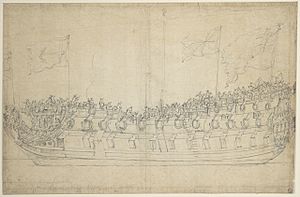HMS Stirling Castle (1679) facts for kids

Stirling Castle by Willem van de Velde
|
|
Quick facts for kids History |
|
|---|---|
| Name | HMS Stirling Castle |
| Builder | John Shish, Deptford Dockyard |
| Launched | 1679 |
| Fate | Wrecked, 1703, on the Goodwin Sands |
| General characteristics as built | |
| Class and type | 70-gun third-rate ship of the line |
| Tons burthen | {105929⁄94 (bm) |
| Length | 151 ft 2 in (46.1 m) (gundeck) |
| Beam | 40 ft 4 in (12.3 m) |
| Depth of hold | 17 ft 3 in (5.3 m) |
| Propulsion | Sails |
| Sail plan | Full-rigged ship |
| Armament | 70 guns of various weights of shot |
| General characteristics after 1699 rebuild | |
| Class and type | 70-gun third-rate ship of the line |
| Tons burthen | 108764⁄94 (bm) |
| Length | 151 ft 2 in (46.1 m) (gundeck) |
| Beam | 40 ft 6 in (12.3 m) |
| Depth of hold | 17 ft 8 in (5.4 m) |
| Propulsion | Sails |
| Sail plan | Full-rigged ship |
| Armament | 70 guns of various weights of shot |
The HMS Stirling Castle was a powerful warship from the English Royal Navy. It was built in 1679 and had 70 guns. This made it a "third-rate" ship of the line, which was a large and important type of warship.
The ship was rebuilt in 1699 to make it even stronger. Sadly, it was lost in a terrible storm in 1703. The Stirling Castle sank near the Goodwin Sands off Deal. Today, its wreck is protected by Historic England because it's an important historical site.
Contents
Building a Mighty Warship
The Stirling Castle was part of a big plan by Samuel Pepys in 1677. This plan was called "Thirty Ships." It was the first time the Royal Navy systematically expanded its fleet. The goal was to replace ships lost in battles, like the Raid on the Medway.
The Stirling Castle was one of 16 "third-rate" ships rebuilt between 1697 and 1706. Other ships rebuilt around this time, like the Northumberland and Restoration, were also lost in the same storm as the Stirling Castle.
Changes and Upgrades
In 1699, the Stirling Castle was rebuilt at Chatham Dockyard. These changes made the ship heavier and improved its design. It was also refitted in 1701.
Historians find the Stirling Castle very interesting. It comes from a time when naval ship design was changing a lot. It shows how the "ship of the line" was developing. This was before official rules were set for how Royal Navy ships should be built.
The Great Storm of 1703
The Stirling Castle was lost during the Great Storm of 1703. This was one of the worst storms in British history. The ship had 349 crew members, but only 70 survived.
The ship seemed to drag its anchor, which slowed it down. This meant it reached the dangerous Goodwin Sands at high tide. This was lucky, as other ships got stuck earlier. But as the storm got worse, the tides changed. The ship was pulled sideways by strong currents and huge waves. The rough seas filled the ship with water. It sank onto the sands, with only its back part sticking out. A few lucky survivors managed to hold onto this part.
Discovering the Wreck
Local divers found the wreck of the Stirling Castle in 1979. This happened after the sand around it shifted. The wreck was in amazing condition, possibly uncovered for the first time since it sank.
Underwater Treasures
Many artifacts were found in 1979-80. Most of these items are now at the Ramsgate Maritime Museum. Some were first shown at Bleak House in Broadstairs and then moved to the Deal Maritime Museum. More artifacts have been found since then.
In 1998, the ship appeared from the sand again. Strong currents caused parts of the ship to collapse. In 2000, divers found a Demi-cannon (a type of large gun). It still had its original gun carriage! This gun was designed by Prince Rupert. It weighed about 49 long hundredweight (around 2,500 kg) and fired a 32-pound (14.5 kg) shot.
In 2002, a wooden block was found. This block might show how the ship's steering wheel was introduced. It might have been added during the 1701 refit. Some experts believe the Stirling Castle had both a steering wheel and an older steering system called a whipstaff. This makes the wreck important for understanding how ship steering changed over time.
Protecting the Site
The HMS Stirling Castle wreck was officially protected in 1980. This means it's illegal to disturb it without permission. The wreck is managed by Historic England. In 1980, the Isle of Thanet Archaeological Unit bought the wreck. Later, they sold shares in the Stirling Castle to help raise money for its study.
Historians are still studying the information and artifacts from the Stirling Castle. In 2016, Historic England released a report about conserving some of the items found on the wreck.

